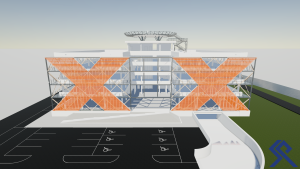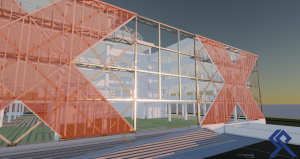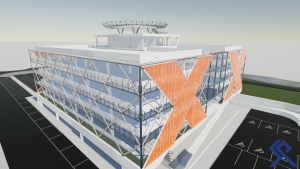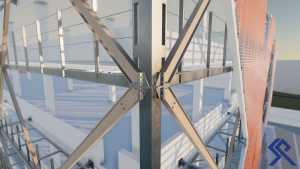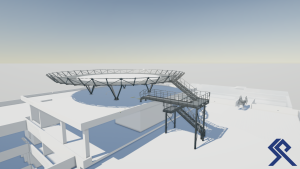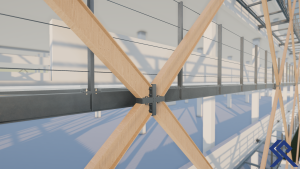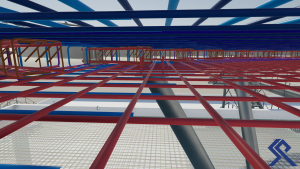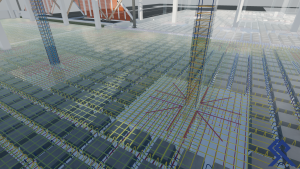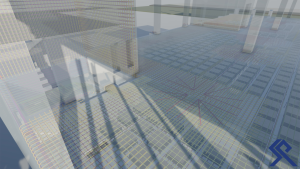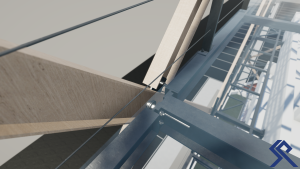 Vítěz kategorie v zemích:
Vítěz kategorie v zemích:
Vývojové a produkční sídlo společnosti CROSS Zlín

| Kategorie | Komerční projekty |
|---|---|
| Rok | 2023 |
| Země | Czech Republic |
| Organizace | Static Point spol. s r.o. |
| Autor | Static Point spol. s r.o. |
| Klient | PSG Construction a.s. |
| Místo stavby | Zlín-Malenovice |
| Tags |
Vývojové a produkční sídlo společnosti CROSS Zlín je pětipodlažní budova nacházející se ve Zlín-Malenovice. Úkolem naší společnosti Static Point spol. s r.o. bylo provést optimalizaci konstrukcí a vytvořit výrobní dokumentaci na betonové i ocelové konstrukce. Veškeré konstrukce v nejvyšší podrobnosti byly modelovány v sjednoceném modelu v Tekla Structures.
Konstrukční systém železobetonových objektů je smíšený. Železobetonové stropní desky jsou podpírány železobetonovými sloupy a vnitřními stěnami.
Sloupy a rohy vnitřních stěn jsou opatřeny smykovými lištami proti protlačení. Základová deska a obvodové podzemní nosné stěny jsou navrženy jako vodonepropustná konstrukce, tzv. bílá vana.
Oproti původní koncepci nosné konstrukce objektu, která spočívala v průvlakovém stropu podpíraném sloupy je nosná konstrukce objektu nahrazena bezprůvlakovými deskami tloušťky 270 mm s rovným podhledem a parapetními nosníky po obvodu. Svislá jádra tvořená sloupy v rozích a nenosnými příčkami po obvodu byla nahrazena plnými železobetonovými stěnami, které jednak mají příznivý vliv na deformace desek, a zejména jednotlivé desky nepřitěžují. Podobným způsobem byly nahrazeny i stěny ve středovém jádru objektu, čímž dochází k lepšímu zavětrování objektu a stropní desky nebudou přitěžovány účinky těchto stěn.
Stropní deska nad 1.PP je navržena jako vylehčená železobetonová deska tl. 320 mm. Vylehčení stropní desky bude provedeno pomocí tvarovek U-BOOT o výšce 160 mm a osových vzdálenostech mezi tvarovkami 680 mm. Vertikální poloha tvarovek bude zajištěna pomocí nožiček o výšce 80 mm.
Celý objekt je založen na soustavě pilot o průměru 630 až 1200mm. Celkem je pod objekt navrženo 118 pilot.
Po obvodu vývojové budovy tvaru „H“ je navržena předsazená ocelová fasáda. Fasáda primárně dotváří architektonickou vizi objektu. Sekundárně vynáší obslužné lávky sloužící k údržbě prosklené fasády. Konstrukčně je fasáda koncipovaná jako systém konzolek, které vynášejí lávky. Konzolky jsou podpírané vnější diagonálním výpletem, který je tvořen nosníky I-profilu.
Diagonální výplet je vhodně nadělen na dilatační prvky, které v kombinaci se dvěma druhy kotvení konzol (kloub x vetknutí) vytváří sestavu, která umožňuje kompenzovat objemové změny od teplotních změn. Vhodné umístění dilatačních detailů umožnilo použít subtilní profily a dosáhnout úspory cca 70t oceli oproti původnímu návrhu.
V osách 2.1 a 2.7 jsou umístěny ocelovou fasádou prvky tvaru „X“. Tyto prvky vynáší stínící lamelový systém a také přispívají svým vzhledem celkové architektonické vizi. Prvky tvaru „X“ jsou s předsazenou fasádou konstrukčně propojeny šroubovanými spoji.
Na střeše objektu se nachází „vertiport“, jehož konstrukci tvoří kruhová železobetonová deska o průměru 15m. Desku lemuje ocelový ochoz, na nějž navazuje ocelové schodiště s lávkou. Deska „vertiportu“ je podpíraná čtyřmi soustavami šikmých sloupů, které jsou s betonovými konstrukcemi spojeny v patě zabetonovanými šrouby a ve zhlaví platlí s trny.
The development and production headquarters of CROSS Zlín is a five-storey building located in Zlín-Malenovice. The task of our company Static Point spol. s r.o. was to optimise the structures and create fabrication documentation for concrete and steel structures. All structures in the highest detail were modelled in a complex model in Tekla Structures.
The structural system of the reinforced concrete buildings is mixed. Reinforced concrete floor slabs are supported by reinforced concrete columns and internal walls.
The columns and corners of the internal walls are fitted with shear rails to prevent punching through. The foundation slab and the perimeter underground load-bearing walls are designed as a watertight structure.
In contrast to the original concept of the building’s load-bearing structure, which consisted of a deck with girders supported by columns, the building’s load-bearing structure is replaced by 270 mm thick non-vaulted slabs with parapet beams around the perimeter. The vertical cores, consisting of columns at the corners and non-load-bearing partitions at the perimeter, have been replaced by solid reinforced concrete walls, which both have a favourable effect on the deformation of the slabs and, in particular, do not strain the individual slabs. The walls in the central core of the building have been replaced in a similar way, which improves the rigidity of the building and means that the ceiling slabs will not be overloaded by the effects of these walls.
The ceiling slab above the underground floor is designed as a lightweight reinforced concrete slab 320 mm thick. The lightening of the ceiling slab will be carried out using U-BOOT fittings with a height of 160 mm and axial distances between the fittings of 680 mm. The vertical position of the fittings will be secured by means of 80 mm high feet.
The whole structure is based on a pile system with a diameter of 630 to 1200 mm. A total of 118 piles are proposed for the building.
A pre-cast steel façade is proposed around the perimeter of the ‚H‘ shaped development building. The façade primarily completes the architectural vision of the building. Secondarily, it carries service walkways used to maintain the glass façade. Structurally, the façade is conceived as a system of cantilevers that carry out the catwalks. The cantilevers are supported by an external diagonal bracing consisting of I-beams.
The steel facade is suitably divided into the expansion assemblies which, in combination with the two types of anchorage of the cantilevers (hinge x fixed), create a set-up that allows to compensate for volume changes from temperature variations. The appropriate positioning of the expansion details allowed the use of subtile profiles and a saving of approximately 70t of steel compared to the original design.
The ‚X‘ shaped elements are placed in axes 2.1 and 2.7 with a steel facade. These elements bring out the shading slat system and also contribute in their appearance to the overall architectural vision. The X-shaped elements are structurally connected to the front façade by bolted joints.
On the roof of the building there is a ‚vertiport‘, which is a circular reinforced concrete slab with a diameter of 15m. The slab is flanked by a steel walkway, which is connected to a steel staircase with a footbridge. The ‚vertiport‘ slab is supported by four sets of inclined columns, which are connected to the concrete structures by bolts set in concrete at the base and by a plate with studs at the top.
